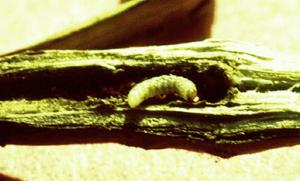|
Return to:
[Mint Stem
Borer Identification]
[Insect
Management]
[Home]
|
|

Mint stem borer occurs in Idaho and Malheur County in
eastern Oregon but damage is minimal and may not be sufficient to justify treatment (Baird et al. 1990). Adults can be sampled during the daytime with
a sweep net from mid-May to mid-June. In Idaho, unpainted wooden lath stakes coated with
stickum have been used to monitor adult activity. Stakes should be placed in the field in
mid-May and checked twice weekly through mid-June. To sample for larvae, take mint stem
samples from several different locations in the field during late June through July. Cut
the stems just below the soil, split the stems, and look for larvae or feeding damage.
Stems of infested plants appear weakened near the soil surface where the eggs are laid and
the larvae are feeding. Plants appear weak with the early visible symptoms of yellowing,
wilting, and lodging. Damage from the mint stem borer is greatest in stressed plants.
Healthy, vigorously growing mint usually does not show symptoms or yield loss despite high
numbers of adults in the field. In Idaho, mint fields 3 to 5 years old or mint that is
under stress (water, fertilizer, root diseases) are most affected by this pest.
Baird et al. (1990) recommend that the best way to control the mint stem borer is to
maintain a healthy stand of mint and avoid stressing the plants through proper irrigation,
fertilization, and disease management. Management of weeds, particularly wild mints,
goldenrod, and Kochia is also important since the mint stem borer may increase in these
weeds growing along ditch banks, roadways, and in waste areas.
Selecting clean planting stock free of overwintering mint stem borer adults will help
insure vigorous plant stands. Also, crop rotation will help maintain healthy, vigorous
stands of mint and prevent serious mint stem borer injury.
No insecticides are registered to control mint stem borer. Control with insecticides is
very difficult because larvae are protected inside mint stems. However, since adults may
be active at about the same time as growers are applying insecticides for cutworm, looper,
and strawberry root weevil adult control, growers may see moderately effective suppression
of mint stem borer adults with the same insecticide application.
Even though the mint stem borer is presently not widespread in all mint production areas
in the Pacific Northwest, it is important to recognize the damage and sample suspected
fields to prevent it from spreading to other growing areas, especially in mint planting
stock. |

